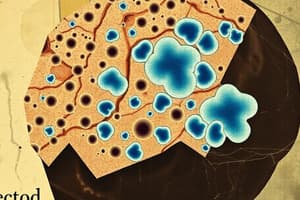Podcast
Questions and Answers
What is the primary characteristic of hyaline cartilage?
What is the primary characteristic of hyaline cartilage?
- Lacks tensile strength
- Most abundant type of cartilage (correct)
- Contains abundant elastic fibers
- Composed of type I collagen
Which type of cartilage is characterized by the presence of both type I and II collagen?
Which type of cartilage is characterized by the presence of both type I and II collagen?
- Articular cartilage
- Hyaline cartilage
- Elastic cartilage
- Fibrocartilage (correct)
Where can fibrocartilage be typically found?
Where can fibrocartilage be typically found?
- At the symphysis of the pubis (correct)
- Within the tracheobronchial system
- In costal cartilages
- In the auricular pavilion
What distinguishes elastic cartilage from hyaline cartilage?
What distinguishes elastic cartilage from hyaline cartilage?
Which of the following statements about chondrocytes is true?
Which of the following statements about chondrocytes is true?
What type of cells are primarily responsible for the maintenance of cartilage?
What type of cells are primarily responsible for the maintenance of cartilage?
Which structure surrounds most types of cartilage and consists of two layers?
Which structure surrounds most types of cartilage and consists of two layers?
What is the main reason cartilage does not heal quickly after an injury?
What is the main reason cartilage does not heal quickly after an injury?
What occurs during interstitial growth of cartilage?
What occurs during interstitial growth of cartilage?
What type of collagen fibers are primarily found in the cartilage matrix?
What type of collagen fibers are primarily found in the cartilage matrix?
Which component of cartilage primarily allows it to resist mechanical forces?
Which component of cartilage primarily allows it to resist mechanical forces?
What initiates the formation of cartilage during embryonic development?
What initiates the formation of cartilage during embryonic development?
What characterizes appositional growth of cartilage?
What characterizes appositional growth of cartilage?
Flashcards
Hyaline Cartilage
Hyaline Cartilage
A type of cartilage that is tough, flexible, and translucent. It is the most abundant and is found in areas like your nose, trachea, and at the ends of bones.
Elastic Cartilage
Elastic Cartilage
A type of cartilage that is also flexible like hyaline cartilage, but it has more elastic fibers, making it even more bendable. It is found in structures like your ears and epiglottis.
Fibrocartilage
Fibrocartilage
A type of cartilage that is a combination of hard hyaline cartilage and strong fibrous connective tissue, making it very resistant to both pulling and pressing forces. It is found in places like intervertebral discs and menisci.
Interstitial Growth
Interstitial Growth
Signup and view all the flashcards
Appositional Growth
Appositional Growth
Signup and view all the flashcards
Cartilaginous Tissue
Cartilaginous Tissue
Signup and view all the flashcards
Chondrocytes
Chondrocytes
Signup and view all the flashcards
Cartilage Matrix
Cartilage Matrix
Signup and view all the flashcards
Lacunae in Cartilage
Lacunae in Cartilage
Signup and view all the flashcards
Interstitial Cartilage Growth
Interstitial Cartilage Growth
Signup and view all the flashcards
Apositional Cartilage Growth
Apositional Cartilage Growth
Signup and view all the flashcards
Perichondrium
Perichondrium
Signup and view all the flashcards
Isogenic Group
Isogenic Group
Signup and view all the flashcards
Study Notes
Cartilaginous Tissue
- Specialized connective tissue
- Main cells are chondrocytes, occupying small cavities called lacunae in the matrix
- Matrix is firm but flexible, resistant to mechanical forces
- Matrix composed of GAGs, proteoglycans, type II collagen fibers, and sometimes elastic fibers
- Avascular tissue, cells nourished by diffusion through the matrix
- Large pieces of cartilage have channels for blood vessels and nerves
- Surrounded by perichondrium, a connective tissue sheath
- Perichondrium has two layers: outer fibrous (collagen type I, fibroblasts, vascularized) and inner cellular (chondroblasts that secrete matrix)
- Chondrocytes are responsible for secreting matrix
- Lacunae (small cavities) house chondrocytes
- Chondrocytes form groups within the same lacunae, called isogenic groups
- Interstitial growth arises from chondrocytes' division and secretion of matrix within the lacunae
- Cells grow in different compartments and increase the size and volume of the tissue
Formation of Cartilage
- During embryonic development, mesenchymal stem cells retract their extensions and group together, forming chondrification centers
- Under the influence of stimuli, these cells differentiate into chondroblasts
- Chondroblasts secrete matrix, then transform into chondrocytes when surrounded by matrix
- Chondrocytes retain their ability to divide
- Can form isogenic groups (groups of cells within same lacuna)
- When cells secrete matrix, they separate, making the cartilage grow from within (interstitial growth)
Types of Cartilage
-
Hyaline cartilage: most abundant type, flexible, semi-translucent, bluish-gray color, uniform, resistant to tensile/compression forces
- Precursor to long bones in embryonic development
- Found in nasal cartilages, larynx, trachea/bronchi, ribs, and articular surfaces
-
Elastic cartilage: similar to hyaline, but contains abundant elastic fibers, very flexible, yellowish color, more opaque compared to hyaline
- Found in the external ear, auditory tubes, epiglottis, and parts of the larynx
-
Fibrocartilage: intermediate between cartilage and dense CT, contains more type I collagen, has scarce matrix, less water and proteoglycans, and great tensile strength
- Has chondrocytes aligned in parallel rows
- Found in intervertebral discs, tendons/ligaments, and the pubic symphysis
Cartilage Growth
- Interstitial growth: chondrocytes divide within cartilage and secrete new matrix, expanding cartilage from within
- Apositional growth: new chondrocytes are formed from the perichondrium, an outer connective tissue layer
- It adds cartilage layers to the outside, increasing cartilage thickness
Studying That Suits You
Use AI to generate personalized quizzes and flashcards to suit your learning preferences.




